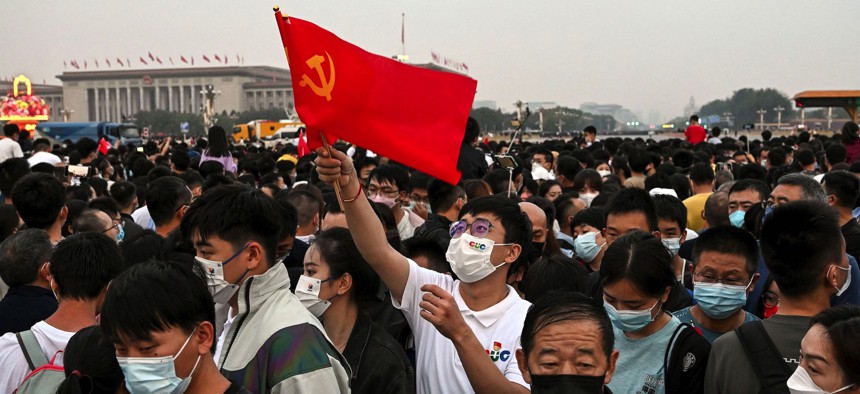
A man waves a flag of the Communist Party of China as people gather near Tiananmen Square during a flag-raising ceremony on China's National Day in Beijing on October 1, 2022. NOEL CELIS/AFP via Getty Images
Is Our Competitor ‘China’ or the Chinese Communist Party?
We should carefully choose the words we use when discussing our strategic competitor.
Words, chosen deliberately, can strengthen or weaken nations. Too often, we conflate “China” and the “Chinese Communist Party,” bolstering the authoritarian regime at the expense of our own strategic goals.
Understanding why requires a bit of linguistic and cultural history. “China,” written 中國, was likely first used during the Warring States period (475-221 BCE) to refer to the central states of the Yellow River valley. During the Song Dynasty (960-1279 CE), it came to describe the civilization at large. The nation-state, however, was not called 中國, but took the name of whichever dynasty was in power at the time.
The dynasties are gone, but this tradition endures. In 1949, control of the traditional territory of “China” passed to the People’s Republic of China (中華人民共和國), a state ruled by the Chinese Communist Party. As understood by Chinese people, the PRC is the political power that controls the civilizational territories of China. Many Chinese-language speakers refer to the PRC as 中共 (pronounced zhong-gong), not 中國 (zhong-guo), emphasizing the second character 共, because it denotes the Communist Party.
The CCP has long aimed to eradicate this distinction between country and party. Current leader Xi Jinping, even more than his predecessors, has striven to condition the people of China to view themselves not as members of the ancient Chinese civilization, but as cogs in the CCP machine. As explained by BBC’s Shanghai correspondent, “the Communist Party strategy has been to try to morph the Party and the machinery of government and the perception of the nation of China into one.”
This has proven difficult. Of the 1.4 billion people in the PRC, just 95 million, or 6.7 percent, are CCP members. The Chinese people have a long history of independent thoughts and actions, far removed from centralized authority. Most identify with their locale—village, city, or province—rather than the state at large. As the Yuan Dynasty proverb goes, 天高皇帝遠 (“Heaven is high and the emperor is far away”).
But Xi’s quest is abetted by the widespread use, in English-language commentary, of “China” to mean the PRC. Positive news brings pride to the Chinese people, while the CCP takes all the credit. And negative news invokes a sense of attack on the civilization at large. This is one of Xi’s most successful tactics: rallying the Chinese people against foreign attacks on 中國 (China). By understanding the differences and correctly using the terms “PRC,” “CCP,” “China,” and “Chinese,” the United States can help the Chinese people defend their cultural and historical identity from sublimation into CCP’s manufactured reality.
Separating the terms not only complicates the CCP’s strategy, it also makes plainer the flaws in Samuel Huntington’s infamous clash-of-civilizations thesis, which argues that differences in cultures make conflict inevitable. One acolyte is Kiron Skinner, the Trump-administration State Department policy-planning director who advanced the notion that competition with the PRC was a unique challenge: “a fight with a really different civilization…a competitor that is not Caucasian.” But as the University of Massachusetts’ Paul Musgrave has written, “whether great-power relations will be cooperative or conflictual” turns on whether we see competition in terms of culture and identity, or in terms of who’s actually running things. Chinese people and those of Chinese heritage are separate from the CCP and the PRC state. By incorrectly using these terms interchangeably, we form and reinforce biases that all Chinese people and members of the diaspora are associated with the CCP and PRC.
The harm we do in conflating the terms extends to our own shores and our own people. Violence against Chinese-Americans, and Asian-Americans in general—long present in American society—is rising again because many mistakenly blame Asian-Americans for the outbreak of COVID-19. When media outlets and political leaders say “China” or “Chinese,” many listeners do not make the distinction between agents of the PRC and people of ethnic Chinese heritage. UCSD professor Susan Shirk has said that overstating the Chinese threat could produce “an anti-Chinese version of the Red Scare that would put all ethnic Chinese under a cloud of suspicion,” and 22 million Asian-Americans could become collateral damage.
Using the correct words to distinguish between the CCP regime and the Chinese people and their ancient civilization is one way to slow Xi’s march toward his goals—and protect the American people both strategically and at home. Defense leaders and writers should take note.
The views expressed in this piece are strictly the author’s and do not reflect the position of the United States Air Force, or the Department of Defense.